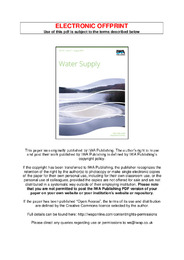Por favor, use este identificador para citar o enlazar este ítem:
https://hdl.handle.net/11000/34551Registro completo de metadatos
| Campo DC | Valor | Lengua/Idioma |
|---|---|---|
| dc.contributor.author | Melendez-Pastor, Ignacio | - |
| dc.contributor.author | Isenstein, Emily | - |
| dc.contributor.author | Navarro-Pedreño, Jose | - |
| dc.contributor.author | Park, M-H. | - |
| dc.contributor.other | Departamentos de la UMH::Agroquímica y Medio Ambiente | es_ES |
| dc.date.accessioned | 2025-01-15T20:01:20Z | - |
| dc.date.available | 2025-01-15T20:01:20Z | - |
| dc.date.created | 2019 | - |
| dc.identifier.citation | Water Supply | es_ES |
| dc.identifier.issn | 1607-0798 | - |
| dc.identifier.issn | 1606-9749 | - |
| dc.identifier.uri | https://hdl.handle.net/11000/34551 | - |
| dc.description.abstract | Cyanobacteria bloom events have been associated with eutrophication processes, along with hydrologic and climate factors. Missisquoi Bay is a portion of Lake Champlain (USA–Canada) that is highly eutrophic and prone to cyanobacteria blooms and cyanotoxins. This study assessed the spatial–temporal influence of nutrients, turbidity and temperature in cyanobacteria distributions during a bloom event in the summer of 2006. Correlations, generalized linear models (GLMs), geostatistics and local indications of spatial association (LISA) autocorrelation analysis tested the influence of nutrient and non-nutrient explanatory variables in cyanobacteria biovolume. Total phosphorus exhibited a high direct correlation with cyanobacteria biovolume. The best performing GLMs included total phosphorus, total nitrogen, Secchi depth (as turbidity) and temperature as explanatory variables of cyanobacteria biovolume. Variogram analysis of those variables resulted in a better understanding of the underlying spatial variation process of the cyanobacteria bloom event. The LISA test revealed a moderate but stable autocorrelation between cyanobacteria biovolume and total phosphorus from 180 to 1,000 m of weight distance, suggesting the possibility of up-scaling the current results to coarse-resolution satellite imagery for more frequent monitoring of bloom events. The LISA test also revealed the spatial–temporal dynamic (movement of cyanobacteria scums) of high cyanobacteria blooms with high total phosphorus concentration. | es_ES |
| dc.format | application/pdf | es_ES |
| dc.format.extent | 15 | es_ES |
| dc.language.iso | eng | es_ES |
| dc.publisher | IWA Publishing | es_ES |
| dc.relation.ispartofseries | 19 | es_ES |
| dc.relation.ispartofseries | 5 | es_ES |
| dc.rights | info:eu-repo/semantics/openAccess | es_ES |
| dc.rights | Attribution-NonCommercial-NoDerivatives 4.0 Internacional | * |
| dc.rights.uri | http://creativecommons.org/licenses/by-nc-nd/4.0/ | * |
| dc.subject | autocorrelation | es_ES |
| dc.subject | cyanobacteria | es_ES |
| dc.subject | harmful algal bloom | es_ES |
| dc.subject | Lake Champlain | es_ES |
| dc.subject | remote sensing | es_ES |
| dc.subject.other | CDU::6 - Ciencias aplicadas::63 - Agricultura. Silvicultura. Zootecnia. Caza. Pesca::631 - Agricultura. Agronomía. Maquinaria agrícola. Suelos. Edafología agrícola | es_ES |
| dc.title | Spatial variability and temporal dynamics of cyanobacteria blooms and water quality parameters in Missisquoi Bay (Lake Champlain) | es_ES |
| dc.type | info:eu-repo/semantics/article | es_ES |
| dc.relation.publisherversion | https://doi.org/10.2166/ws.2019.017 | es_ES |

Ver/Abrir:
Investigacion-publicaciones-2019-SpatialVariabilityTemporal.pdf
1,34 MB
Adobe PDF
Compartir:
 La licencia se describe como: Atribución-NonComercial-NoDerivada 4.0 Internacional.
La licencia se describe como: Atribución-NonComercial-NoDerivada 4.0 Internacional.
.png)